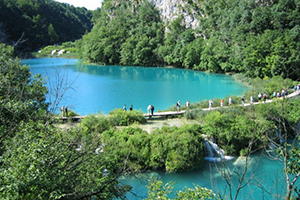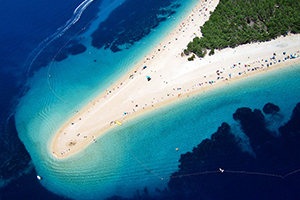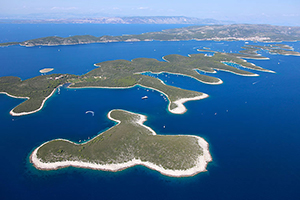 Zagreb, Croatia’s capital, is not just a random city. Since its earliest days, it has been one of the closest Balkan capitals to Europe, not only in looks but also in the people’s attitude and the buildings’ architecture. Founded in the 1st century A.D. as Andautonia, Zagreb came to notice in the 11th century with the founding of a diocese by Hungarian King Ladislaus who was returning from a victory. Zagreb has had a relatively calm history, with slow but steady development. Because of its physical proximity to Europe, it has always had a European touch. This was noticed more in the 19th century in the National Revival movement. Today, The tours in Croatia, especially Zagreb tours, have many tourist attractions to offer, such as Burza Square, Mirogoj Cemetery, Sava River, Mimara Museum, Zagreb Cathedral, etc.
Zagreb, Croatia’s capital, is not just a random city. Since its earliest days, it has been one of the closest Balkan capitals to Europe, not only in looks but also in the people’s attitude and the buildings’ architecture. Founded in the 1st century A.D. as Andautonia, Zagreb came to notice in the 11th century with the founding of a diocese by Hungarian King Ladislaus who was returning from a victory. Zagreb has had a relatively calm history, with slow but steady development. Because of its physical proximity to Europe, it has always had a European touch. This was noticed more in the 19th century in the National Revival movement. Today, The tours in Croatia, especially Zagreb tours, have many tourist attractions to offer, such as Burza Square, Mirogoj Cemetery, Sava River, Mimara Museum, Zagreb Cathedral, etc.

Dubrovnik, one of the most amazingly beautiful cities in Europe, was called a “paradise on earth” by George Bernard Shaw. There are many theories related to its founding. The most reliable one tells of being founded by Epidaurum refugees after the city was destroyed in 7th century. It first came to be known as the Republic of Ragusa, a small but powerful merchant state. Soon it fell to the Byzantium Empire and later to Venice. The city developed and grew on the peninsula where is located. Fortunately, the fortress and the city inside it were unharmed from time and battles until 1991 in the Serbian-Croatian war, when Dubrovnik was badly damaged but quickly reconstructed. Now it is on the UNESCO World Heritage List and with its tours in Croatia, one of the most visited destinations in the world due to its cultural, historic and natural attractions. Visiting Dubrovnik, you can see why it is called the Pearl of the Adriatic.
 As the largest coastal city, especially along the Dalmatian coastline, Split is charged with a great deal of responsibility to deliver top attractions to every tourist. With a long and busy history, the Split of today is a modern town with bars and restaurants that co-exist with its history in the cobbled streets, the stone pavements, the old walls, and especially, with what the great Emperor Diocletian left for the history to see; one of the greatest royal palaces to date. Tired of history? Take a swim in one of the many beaches. Or simply take a walk in the rocky shores of Adriatic.
As the largest coastal city, especially along the Dalmatian coastline, Split is charged with a great deal of responsibility to deliver top attractions to every tourist. With a long and busy history, the Split of today is a modern town with bars and restaurants that co-exist with its history in the cobbled streets, the stone pavements, the old walls, and especially, with what the great Emperor Diocletian left for the history to see; one of the greatest royal palaces to date. Tired of history? Take a swim in one of the many beaches. Or simply take a walk in the rocky shores of Adriatic.
 Plitvice National Park, the oldest national park in Europe and the largest in Croatia, is unique. It was founded in 1949 in the middle of the famous Karst Mountains in central Croatia, close to the border with Bosnia. Each year it hosts over one million tourists who come to see this natural Balkan jewel. Itsbest feature is the lakes that are arranged in cascades flowing one into the other. There are 16 lakes that are visible;others are supposed to be underground along with underground small karst rivers. The Plitvice National Park is a European wonder that you should not miss in your journey.
Plitvice National Park, the oldest national park in Europe and the largest in Croatia, is unique. It was founded in 1949 in the middle of the famous Karst Mountains in central Croatia, close to the border with Bosnia. Each year it hosts over one million tourists who come to see this natural Balkan jewel. Itsbest feature is the lakes that are arranged in cascades flowing one into the other. There are 16 lakes that are visible;others are supposed to be underground along with underground small karst rivers. The Plitvice National Park is a European wonder that you should not miss in your journey.
 Main tourists attraction in Croatia have always been its beaches.Croatia’s Adriatic Sea mainland coast is 1,777.3 kilometres. Most of the Croatian beaches are not sandy, but gravel, pebble or rocky. These beaches are the main reason why Croatia is one of the most popular summer destinations in the world. There are about 400 beaches along the Adriatic Sea and islands from Dalmatia, Kvarner to Istria. Croatia’s beaches and its water, overall, are very well maintained. They have a ” Blue Flag programme” which awards with a prestigious Blue Flag the beaches that meet certain requirements like water quality, environment, safety , etc . In 2018, 91 beaches were awarded a Blue Flag.If you really like crystal clear water and you want to find this kind of beaches in Croatia, that will not be a problem for you. In Croatia you can also find any type of beaches that you like ; family beaches, secluded beaches, beaches for young people and beaches suitable for sea sports, etc. With all this interesting beaches you will enjoy swimming and sunbathing during you time in Croatia.
Main tourists attraction in Croatia have always been its beaches.Croatia’s Adriatic Sea mainland coast is 1,777.3 kilometres. Most of the Croatian beaches are not sandy, but gravel, pebble or rocky. These beaches are the main reason why Croatia is one of the most popular summer destinations in the world. There are about 400 beaches along the Adriatic Sea and islands from Dalmatia, Kvarner to Istria. Croatia’s beaches and its water, overall, are very well maintained. They have a ” Blue Flag programme” which awards with a prestigious Blue Flag the beaches that meet certain requirements like water quality, environment, safety , etc . In 2018, 91 beaches were awarded a Blue Flag.If you really like crystal clear water and you want to find this kind of beaches in Croatia, that will not be a problem for you. In Croatia you can also find any type of beaches that you like ; family beaches, secluded beaches, beaches for young people and beaches suitable for sea sports, etc. With all this interesting beaches you will enjoy swimming and sunbathing during you time in Croatia.
 Croatia is not just about visiting Dubrovnik or Zagreb. The country is also home to many beautiful islands.Croatia has more than a thousand islands(about 1244 islands). All of them are dotted along the Croatian coast of the Adriatic Sea. Some of the islands are larger and inhabited, others are smaller and deserted. The largest island is Krk Island 409 km2.The region of the most beautiful coastline and numerous islands is called Dalmatia. Join our tours in Albania and you will find a lot of interesting things in these islands and they are so many islands that choosing one to visit sometimes can be tough.
Croatia is not just about visiting Dubrovnik or Zagreb. The country is also home to many beautiful islands.Croatia has more than a thousand islands(about 1244 islands). All of them are dotted along the Croatian coast of the Adriatic Sea. Some of the islands are larger and inhabited, others are smaller and deserted. The largest island is Krk Island 409 km2.The region of the most beautiful coastline and numerous islands is called Dalmatia. Join our tours in Albania and you will find a lot of interesting things in these islands and they are so many islands that choosing one to visit sometimes can be tough.
 Zagreb, Croatia’s capital, is not just a random city. Since its earliest days, it has been one of the closest Balkan capitals to Europe, not only in looks but also in the people’s attitude and the buildings’ architecture. Founded in the 1st century A.D. as Andautonia, Zagreb came to notice in the 11th century with the founding of a diocese by Hungarian King Ladislaus who was returning from a victory. Zagreb has had a relatively calm history, with slow but steady development. Because of its physical proximityto Europe, it has always had a European touch. This was noticed more in the 19th century in the National Revival movement. The tours in Croatia, especially Zagreb tours, have many tourist attractions to offer, such as Burza Square, Mirogoj Cemetery, Sava River, Mimara Museum, Zagreb Cathedral, etc.
Zagreb, Croatia’s capital, is not just a random city. Since its earliest days, it has been one of the closest Balkan capitals to Europe, not only in looks but also in the people’s attitude and the buildings’ architecture. Founded in the 1st century A.D. as Andautonia, Zagreb came to notice in the 11th century with the founding of a diocese by Hungarian King Ladislaus who was returning from a victory. Zagreb has had a relatively calm history, with slow but steady development. Because of its physical proximityto Europe, it has always had a European touch. This was noticed more in the 19th century in the National Revival movement. The tours in Croatia, especially Zagreb tours, have many tourist attractions to offer, such as Burza Square, Mirogoj Cemetery, Sava River, Mimara Museum, Zagreb Cathedral, etc.
 As the largest coastal city, especially along the Dalmatian coastline, Split is charged with a great deal of responsibility to deliver top attractions to every tourist. With a long and busy history, the Split of today is a modern town with bars and restaurants that co-exist with its history in the cobbled streets, the stone pavements, the old walls, and especially, with what the great Emperor Diocletian left for the history to see; one of the greatest royal palaces to date. Tired of history? Take a swim in one of the many beaches. Or simply take a walk in the rocky shores of Adriatic.
As the largest coastal city, especially along the Dalmatian coastline, Split is charged with a great deal of responsibility to deliver top attractions to every tourist. With a long and busy history, the Split of today is a modern town with bars and restaurants that co-exist with its history in the cobbled streets, the stone pavements, the old walls, and especially, with what the great Emperor Diocletian left for the history to see; one of the greatest royal palaces to date. Tired of history? Take a swim in one of the many beaches. Or simply take a walk in the rocky shores of Adriatic. Plitvice National Park, the oldest national park in Europe and the largest in Croatia, is unique. It was founded in 1949 in the middle of the famous Karst Mountains in central Croatia, close to the border with Bosnia. Each year it hosts over one million tourists who come to see this natural Balkan jewel. Itsbest feature is the lakes that are arranged in cascades flowing one into the other. There are 16 lakes that are visible;others are supposed to be underground along with underground small karst rivers. The Plitvice National Park is a European wonder that you should not miss in your journey.
Plitvice National Park, the oldest national park in Europe and the largest in Croatia, is unique. It was founded in 1949 in the middle of the famous Karst Mountains in central Croatia, close to the border with Bosnia. Each year it hosts over one million tourists who come to see this natural Balkan jewel. Itsbest feature is the lakes that are arranged in cascades flowing one into the other. There are 16 lakes that are visible;others are supposed to be underground along with underground small karst rivers. The Plitvice National Park is a European wonder that you should not miss in your journey. Main tourists attraction in Croatia have always been its beaches.Croatia’s Adriatic Sea mainland coast is 1,777.3 kilometres. Most of the Croatian beaches are not sandy, but gravel, pebble or rocky. These beaches are the main reason why Croatia is one of the most popular summer destinations in the world. There are about 400 beaches along the Adriatic Sea and islands from Dalmatia, Kvarner to Istria. Croatia’s beaches and its water, overall, are very well maintained. They have a ” Blue Flag programme” which awards with a prestigious Blue Flag the beaches that meet certain requirements like water quality, environment, safety , etc . In 2018, 91 beaches were awarded a Blue Flag.If you really like crystal clear water and you want to find this kind of beaches in Croatia, that will not be a problem for you. In Croatia you can also find any type of beaches that you like ; family beaches, secluded beaches, beaches for young people and beaches suitable for sea sports, etc. With all this interesting beaches you will enjoy swimming and sunbathing during you time in Croatia.
Main tourists attraction in Croatia have always been its beaches.Croatia’s Adriatic Sea mainland coast is 1,777.3 kilometres. Most of the Croatian beaches are not sandy, but gravel, pebble or rocky. These beaches are the main reason why Croatia is one of the most popular summer destinations in the world. There are about 400 beaches along the Adriatic Sea and islands from Dalmatia, Kvarner to Istria. Croatia’s beaches and its water, overall, are very well maintained. They have a ” Blue Flag programme” which awards with a prestigious Blue Flag the beaches that meet certain requirements like water quality, environment, safety , etc . In 2018, 91 beaches were awarded a Blue Flag.If you really like crystal clear water and you want to find this kind of beaches in Croatia, that will not be a problem for you. In Croatia you can also find any type of beaches that you like ; family beaches, secluded beaches, beaches for young people and beaches suitable for sea sports, etc. With all this interesting beaches you will enjoy swimming and sunbathing during you time in Croatia. Croatia is not just about visiting Dubrovnik or Zagreb. The country is also home to many beautiful islands. Croatia has more than a thousand islands(about 1244 islands). All of them are dotted along the Croatian coast of the Adriatic Sea. Some of the islands are larger and inhabited, others are smaller and deserted. The largest island is
Croatia is not just about visiting Dubrovnik or Zagreb. The country is also home to many beautiful islands. Croatia has more than a thousand islands(about 1244 islands). All of them are dotted along the Croatian coast of the Adriatic Sea. Some of the islands are larger and inhabited, others are smaller and deserted. The largest island is 